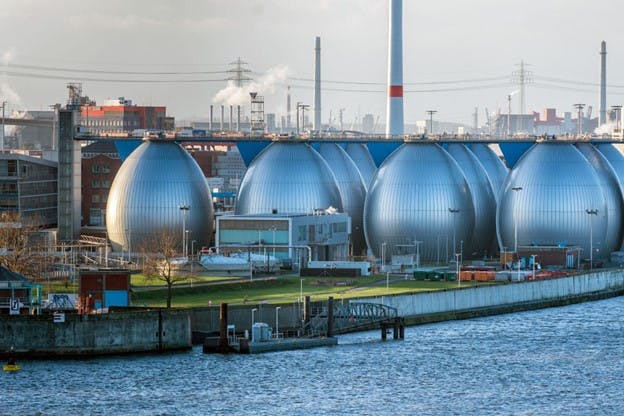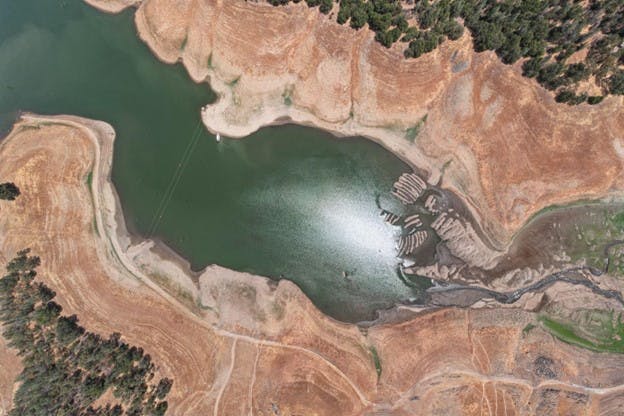January 2024
Making Waves: How Water Desalination Could Quench Our Thirst
The world has an abundance of water. It’s absolutely everywhere. But only roughly 2% of it is freshwater that is useful for drinking and bathing in. More than 97% remaining is salt water or brackish water that we can’t use. As our useful water supply is stretched thin, we are forced to figure out a way to make saltwater drinkable. Desalination is how we’re going to make that happen.
But how does desalination work and what are the hurdles we need to get over to make it a reality across the world? In this article, we’re going to take a deep dive into water desalination to answer these questions. We’ll see where in the world the desalination process is being employed and what lessons we’re learning from it.
What Is Desalination?
Water desalination is the process of removing dissolved salts and mineral ions from sea water or saline water to make it drinkable fresh water. With the United Nations estimating that over 2 billion people in the world currently don’t have reliable access to clean drinking water, desalination is being looked at more and more as a possible solution.
Desalination is not a new concept. It’s been explored by civilizations for thousands of years. Aristotle noted that when you captured the steam from boiling salt water, the resulting water was no longer salty. He also found that if you seal a jar in a fine wax and submerge it in salt water, all that seeped through the wax into the jar was fresh water since the minerals were too large to pass through. These two processes, which we now know as distillation and reverse osmosis, are the same ones we use today.
The challenge has always been to do desalination in large enough quantities and at a low enough cost to make it worth doing on a large scale. Currently it costs more energy to desalinate water at scale than it does to power a small town. And questions of what to do with the resulting brine as well as the high energy and environmental costs have relegated its usefulness to just ships, submarines, and a few wealthy coastal cities.
How Does Desalination Work?
There are many processes used for desalination but they all boil down to some form of distillation or reverse osmosis.
Distillation Methods of Water Desalination
Distillation is the process of separating water from contaminants through evaporation. The resulting clean vapor or steam is then captured and becomes purified water.
Here are the different distillation methods used in seawater desalination plants throughout the world:
- Solar distillation: This method uses solar energy to mimic the natural water cycle, heating sea water to cause evaporation and then condensing the vapor into fresh water. It can utilize solar panels for energy or directly convert solar energy to heat.
- Vacuum distillation: This technique reduces atmospheric pressure around the water, lowering the temperature needed for evaporation. It's efficient because it can use low-temperature “waste” heat from other processes.
- Multi-stage flash distillation: In this method, sea water is evaporated in multiple stages, where each stage recycles heat from the previous one, making it more energy-efficient.
- Multiple-effect distillation: This process involves heating sea water through a series of stages, each using the steam generated in the previous stage, making it highly efficient, especially when paired with heat from power plants.
- Vapor-compression distillation: This method compresses vapor above the sea water to provide the heat for further evaporation. It's cost-effective at a small scale as it primarily requires power.
- Wave-powered desalination: This innovative approach uses mechanical wave motion to power the reverse osmosis process, making it efficient by bypassing the need for electricity conversion.
- Membrane distillation: Here, a temperature difference across a membrane is used to evaporate water from a saline solution, with the pure water condensing on the cooler side. The membrane's design is crucial for its efficiency and durability.
Reverse Osmosis Desalination Methods
Reverse osmosis is the process of forcing water through holes of a membrane that are so small, only the water molecules can fit through. This too results in purified, fresh water.
Here are the different reverse osmosis-based methods used in desalination plants throughout the world:
- Forward osmosis: This method uses a semi-permeable membrane and an osmotic pressure gradient, often created by a highly concentrated solution, to separate water from solutes.
- Freeze-thaw desalination: This approach involves freezing saltwater and then collecting the naturally desalinated meltwater upon thawing. One variation of this method works in a vacuum, where seawater is frozen, and the ice (desalinated) is melted for collection.
- Electrodialysis: This process uses electric potential to move salts through charged membranes, effectively trapping salt. It can also remove salt and carbonic acid from seawater, potentially offsetting costs by selling the byproduct desalinated water.
- Microbial desalination cells: These are biological electrochemical systems using electro-active bacteria to power the desalination process. The bacteria create a natural anode and cathode gradient, acting as an internal supercapacitor to desalinate water in situ.
Why Is Desalination Used as a Water Source?
While most of Earth's water is saltwater unsuitable for human consumption, our fresh water sources like lakes, rivers, and groundwater are under strain due to population growth and climate change. Desalination offers a way to tap into our abundance of ocean water in order to fill our needs for drinking, sanitation, and agriculture.
In regions facing severe water scarcity, especially arid and drought-prone areas, desalination is sometimes the best solution. Countries like Israel and Saudi Arabia have adopted desalination to fulfill a significant portion of their water needs. In the U.S., some cities are starting to rely on removing salinity from water more than ever. Florida cities like Miami, Tampa, and Palm Beach get tens of millions of gallons per day while the Carlsbad Desalination Plant in San Diego, California puts out 50 million gallons per day.
Is Desalinated Water Safe to Drink?
Yes, desalinated water is safe to drink. The process required for removing salt and minerals is so rigorous that it leaves the water purified and safe. However, it's important to note that desalination strips away not just contaminants but also beneficial minerals that contribute to water's taste and nutritional value.
Most desalination plants address this by adding essential minerals back into the water post-treatment, balancing its health benefits and improving its taste. This remineralization process is crucial in giving desalinated water back the health benefits and taste of water from a natural, freshwater source.
What Are the Environmental Impacts of Desalination?
While water desalination technologies are an important tool for addressing fresh water shortages, there are still many environmental challenges to figure out. The biggest issue is that these water treatment methods require an enormous amount of energy to heat and capture water through distillation. Reverse osmosis desalination plants are usually more energy efficient but they still need to produce high pressure to force millions of gallons of water through semipermeable membranes.
While new creative sources of renewable energy are being explored and advanced, greenhouse gas-producing fossil fuels still dominate the energy landscape, especially in the Middle East where these technologies are being used the most.
Another major environmental challenge is the disposal of brine, the wastewater byproduct of desalination. Brine has high levels of salinity and often contains chemicals from the desalination process. If discharged back into the ocean, it can harm marine ecosystems, altering the salinity and temperature of the surrounding water.
Another place desalination can impact marine life at the intake stage. Large volumes of seawater are drawn into the plant, potentially entrapping small sea creatures. All of these problems are being worked on and progress is being made, but there’s still a lot of improvement to be made before desalination projects can meaningfully add to the world's usable water resources.
Where Is Desalination Commonly Used Around the World?
Desalination plants have been used around the world for decades but mainly in coastal and arid cities, which lack access to freshwater from surface water and groundwater aquifers. Due to the expense, desalination has mainly been used in wealthy cities. Here are some of the largest users of desalination technology by region and country:
- Middle East and North Africa (MENA): This region is the largest user of desalination technologies due to its arid climate and scarcity of freshwater sources. Countries like Saudi Arabia, the United Arab Emirates, and Israel have invested heavily in desalination plants. Israel is able to meet a significant portion of its domestic water demand through desalination.
- Australia: With its long coastlines and dry interior, Australia has turned to desalination to supplement its water use, especially in cities like Perth and Sydney.
- United States: In the U.S., desalination is used in coastal areas with limited freshwater sources, such as California, Texas, and Florida. California's Carlsbad Desalination Plant is the largest in the country.
- China: China has been expanding its desalination capacity, mainly to supply water to its northern regions, which suffer from severe water shortages.
How Energy-Intensive Is the Desalination Process?
Water desalination is a very energy intensive process. While the amount of power needed can vary with the method or the amount of salt being removed, it can take tens of megawatts of power to desalinate tens of millions of gallons of water.
To put that into context, 1 megawatt will power roughly 200 average American homes for a day.
Can Desalination Contribute to Sustainable Water Management?
According to the International Desalination Association, over 300 million people already receive their water from desalination plants. As we find and improve on methods of powering these plants with renewable energy, it’s likely that more regions around the world will utilize desalination technologies.
What Is the Cost of Desalinated Water Compared to Other Sources?
The high energy cost of desalinating water means the dollar cost is equally high. At the Carlsbad Desalination Plant in San Diego, it’s estimated that water from the plant costs twice as much as any other water source for the city. Often, it's much cheaper to transport fresh water from far away than it is to desalinate water locally.
Is Desalination the Answer to Our Potable Water Needs?
As our freshwater supplies are increasingly strained by population growth and climate change, desalination technologies become more important. With only about 5% of the world’s potable water coming from desalination, expanding this into the future will require advances in renewable energy and waste disposal.
No matter where your tap water comes from, if you want the best water quality you can get, HomeWater can help. Our American-made UPSTREAM 4-Stage Whole Home Water Filter uses a blend of red flint, KDF55, and catalytic carbon to deliver superior filter performance to every faucet in your home. It easily filters chlorine, heavy metals, sediment, VOCs, PFOS/PFAS, microplastics, and more.
Unsure of your filter needs? Take our fast Filter Quiz and get our best recommendation in minutes.



